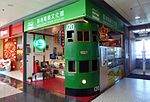British Hong Kong

British Hong Kong was a colony and dependent territory of the British Empire from 1841 to 1997, apart from a period under Japanese occupation from 1941 to 1945. The colonial period began with the occupation of Hong Kong Island in 1841 during the First Opium War. The island was ceded to Great Britain by the Treaty of Nanking, ratified by the Daoguang Emperor in the aftermath of the war of 1842. It was established as a Crown colony in 1843. The colony expanded to include the Kowloon Peninsula in 1860 after the Second Opium War. Hong Kong's territory was further extended in 1898 when the British obtained a 99-year lease of the New Territories. Although China ceded Hong Kong Island and Kowloon in perpetuity, the leased New Territories comprised the vast majority of the total area. Britain did not see any viable way to divide the colony, while the People's Republic of China would not consider extending the lease or allowing British administration thereafter. With the signing of the Sino-British Joint Declaration, which states that the social and economic systems in Hong Kong would remain unchanged for 50 years, the British government agreed to transfer the entire territory to China upon the expiration of the New Territories lease in 1997.
Excerpt from the Wikipedia article British Hong Kong (License: CC BY-SA 3.0, Authors, Images).British Hong Kong
Pok Fu Lam Reservoir Road, Hong Kong Island The Peak (Central and Western District)
Geographical coordinates (GPS) Address Nearby Places Show on map
Geographical coordinates (GPS)
| Latitude | Longitude |
|---|---|
| N 22.266666666667 ° | E 114.15 ° |
Address
薄扶林水塘道 Pok Fu Lam Reservoir Road
Pok Fu Lam Reservoir Road
Hong Kong Island, The Peak (Central and Western District)
Hong Kong, China
Open on Google Maps











